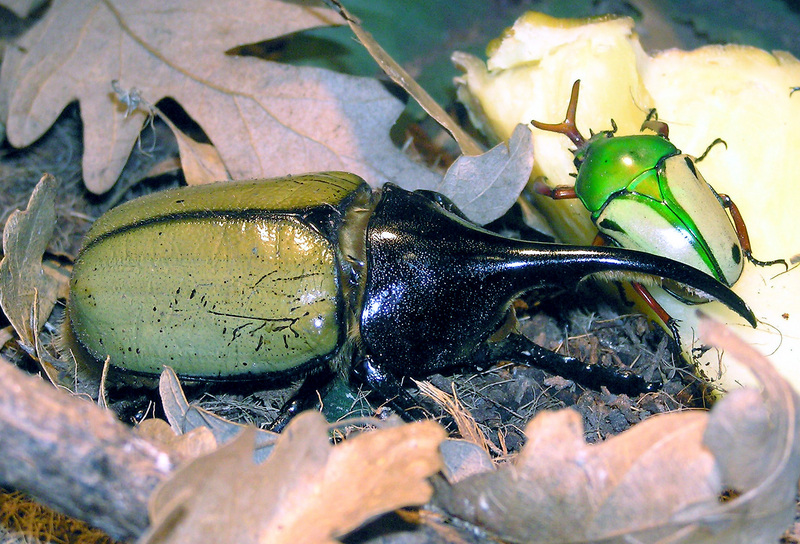|
| Query: Eudicella smithii | Result: 1st of 1 | |
Hercules Beetle (Dynastes hercules) - Wiki
| Subject: | Hercules Beetle (Dynastes hercules) - Wiki
| |

| Resolution: 1768x1203
File Size: 945982 Bytes
Date: 2006:04:23 11:57:47
Camera: C750UZ (OLYMPUS CORPORATION)
F number: f/3.2
Exposure: 10/1000 sec
Focal Length: 175/10
Upload Date: 2007:12:24 10:47:45
|
Hercules beetle
From Wikipedia, the free encyclopedia
Order: Coleoptera
Family: Scarabaeidae
Subfamily: Dynastinae
[Photo] Male Hercules beetle, Dynastes hercules. The green beetle in the background is the flamboyant flower beetle, Eudicella gralli. (Original Description: Hercules beetle Dinastes hercules, a member of the Rhinoceros beetle family, at Bristol Zoo, England. The green beetle on the right is a Jade headed buffalo beetle Eudicella smithii.). Photographed by Adrian Pingstone (http://commons.wikimedia.org/wiki/User:Arpingstone) in May 2006 and released to the public domain.
The Hercules beetle (Dynastes hercules) is the most famous of the rhinoceros beetles. Native to the rain forests of Central and South America, their title is well deserved, with some (exceptionally rare) males reaching 6.75 inches (170 mm) in length. It is the largest of the 6 species in the Dynastes genus, and one of the largest beetles known, being exceeded in length by only two other beetles in the family Cerambycidae, Macrodontia cervicornis (specimens of 170-175 mm are known) and Titanus giganteus (several 180+ mm specimens are known to exist). However, if the horns are excluded, this species drops considerably farther down in the size rankings. One reason for this is that the development of the horns is allometric, as well as sexually dimorphic, and thus not strictly correlated to actual body size; it is possible for a female to be much longer, measured from eyes to abdomen, than a male, yet be considered "smaller" simply due to the absence of horns.
This scarab beetle is most noted for its thoracic and cephalic horns, which can grow longer than the body of the beetle itself. This adaptation is primarily used during fights with other males. Features of this species are the numerous small black spots on the elytra and the thick hairs on the underside of the thoracic horn. The Hercules beetle is said to be the strongest creature on earth for its size, able to carry 850 times its own body weight.
As noted above, Hercules beetles are highly sexually dimorphic, with the females generally being larger-bodied but much shorter, as they lack horns entirely. The larval stage of the Hercules beetle will last one to two years, with the larva growing up to 4.5 inches (110 mm) in length and weighing up to 120 grams. Much of the life of the larva is spent tunneling through its primary food source of rotting wood. After the larval period, transformation into a pupa and then molting will occur, the beetle then emerging as an adult. Adults will roam the forest floor in search of decaying fruit.
http://en.wikipedia.org/wiki/Hercules_beetle
| The text in this page is based on the copyrighted Wikipedia article shown in above URL. It is used under the GNU Free Documentation License. You may redistribute it, verbatim or modified, providing that you comply with the terms of the GFDL. |
|
^o^
Animal Pictures Archive for smart phones
^o^
|
|

